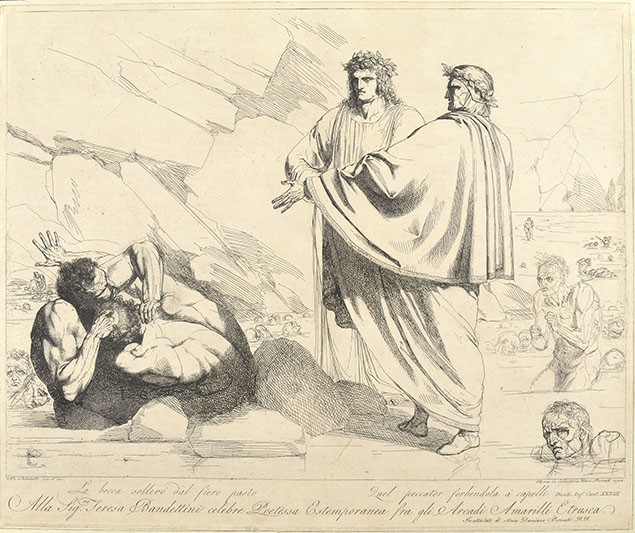(Florence 1772 - Milan 1850)
DANTE'S INFERNO: TRAITORS IN THE ICE OF THE COCYTUS. THE MEETING WITH COUNT UGOLINO, 1794
Etching, 1794, an impression of the un described first state of two, extensively touched in pen and black ink. 414 x 502 mm.
Though studies of this etching have never considered whether earlier states of the plate existed, there can be no doubt that there were in fact two states. This is evidenced by the differences in lettering at the lower margins of the impressions.
The first state has a dedication to Teresa Bandettini, a dancer and acclaimed poet who in 1793, a year before the creation of this work, had performed in Pavia improvising Dante’s verses on Count Ugolino. Another feature that distinguishes this state is the inscription at the bottom right, just below the engraving: Roma in Collectione Da. Pernati 1794. Also at the bottom right under the dedication is the following inscription: In attestato di stima Damiano Pernati D.D. Damiano Pernati was a close friend of the young Sabatelli and executed a number of etchings after Luigi's drawings.
In the second state (see here the impression preserved in the Rijksmuseum) they have been replaced by a single inscription at the centre which reads: In Roma presso Montagnani-Mirabili a Pasquino. As in the state described above, the following inscriptions were retained: Alo. Sabatelli inv. et inc. and the passage from the Divine Comedy from which the scene is taken, La bocca sollevò dal fiero pasto Quel peccator forbendola a capelli - Dante. Inf. Cant. XXXIII. Finally the number 34 has been added to the top right corner.
These changes were made on the occasion of the publication in 1804 of the Raccolta di soggetti pittorici inventati da Luigi Sabbatelli pittore fiorentino, illustrating the plates engraved by Sabatelli himself as well as those of his friend Pernati.
Alongside the freshness of the impression, what makes it unique are numerous interventions in pen and ink. These comprise hatching lines in the foreground at the left, where the ravenous Count Ugolino devours one of his sons, as well as additions to the skeletal character in the middle-distance, seen at the extreme right of the composition. In each case the extensive hatched shading is typical of Sabatelli’s penwork of this period, so skilfully worked that it almost deceives the eye as it blends in with the engraved lines.
The interventions to the group of Count Ugolino are around the area of his stomach, which is completely shaded. Moreover, a series of dots skilfully applied enhances the chiaroscuro on his right arm, his deltoid and triceps as well as his radial extensor.
Further shading in pen and ink can be seen on the body of the count's victim. In particular, on the right-hand side of his back where it extends the shadow falling onto the upper region of the latissimus dorsi, and onto the left of the teres major muscle. Again, the pattern of the drawn hatched linework is fully consistent with Sabatelli's style and technique as an etcher, making it difficult to at first glance to realise that it is in pen and ink.
We can therefore hypothesise that the young Luigi, twenty-two years old at the time, retouched the impression by hand so as to asses the consequences of intensifying the shaded areas of his composition; a practice commonly used by engravers before deciding whether or not to further intervene again on the plate itself.
RESERVED
Sabatelli was the most talented of the Tuscan painters of the generation after Pietro Benvenuti. He was born in the house of Marchese Pier Roberto Capponi, in Florence, while his own father was in domestic service there. The Marchese Capponi was Sabatelli's early sponsor, financing his education at the Florentine Academy and his sojourns in Rome and Venice. In 1808 Luigi Sabatelli was appointed to the chair of painting at the Brera Academy in Milan. There he remained over forty years, although he continued to carry out commissions in Tuscany. During his mature years, Sabatelli established himself as a decorator and fresco painter, with numerous public and private commissions. Sabatelli was a fine painter and one of the premier pre-romantic draftsmen of nineteenth century Italy. He was also an accomplished etcher. See Beatrice Paolozzi Strozzi, Luigi Sabatelli, disegni e incisioni, catalogue of the exhibition at the Gabinetto Disegni e Stampe degli Uffizi, Florence, 1978.

.jpeg)
